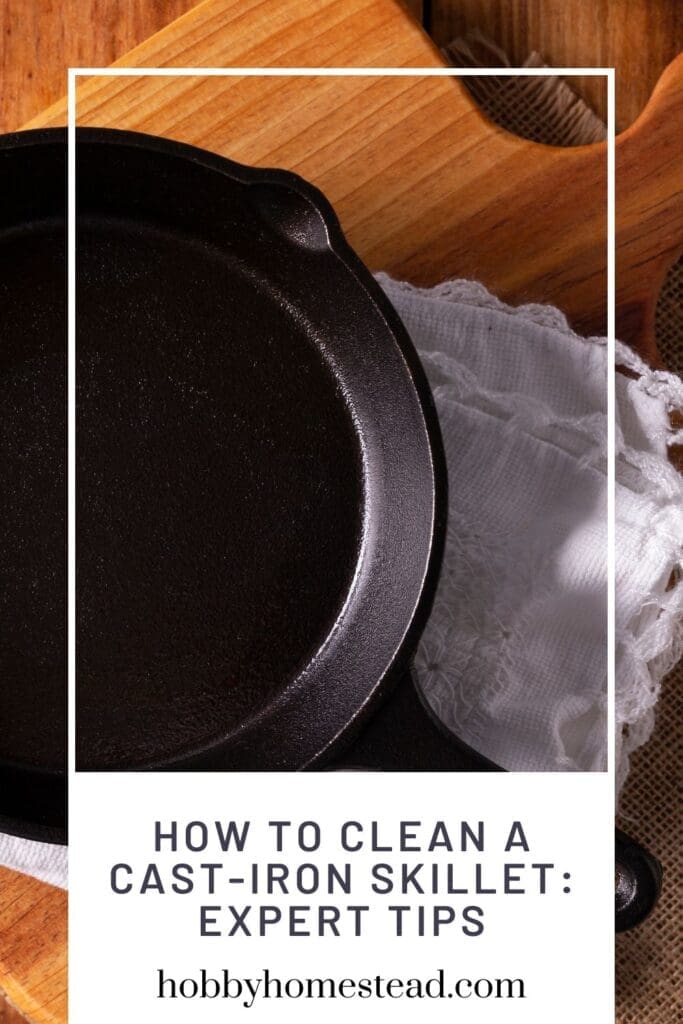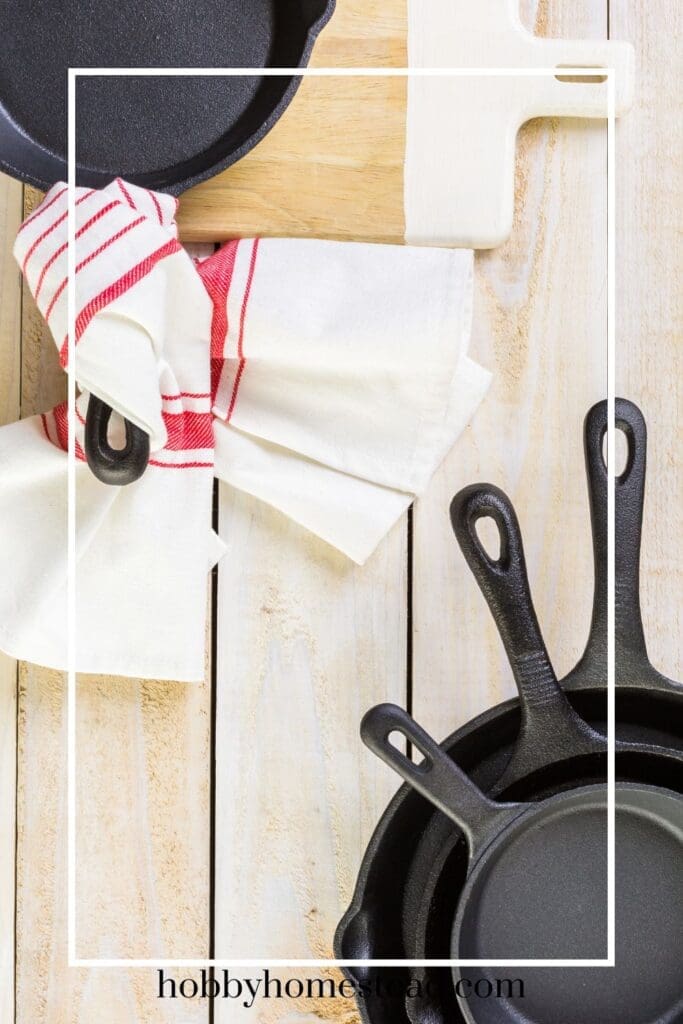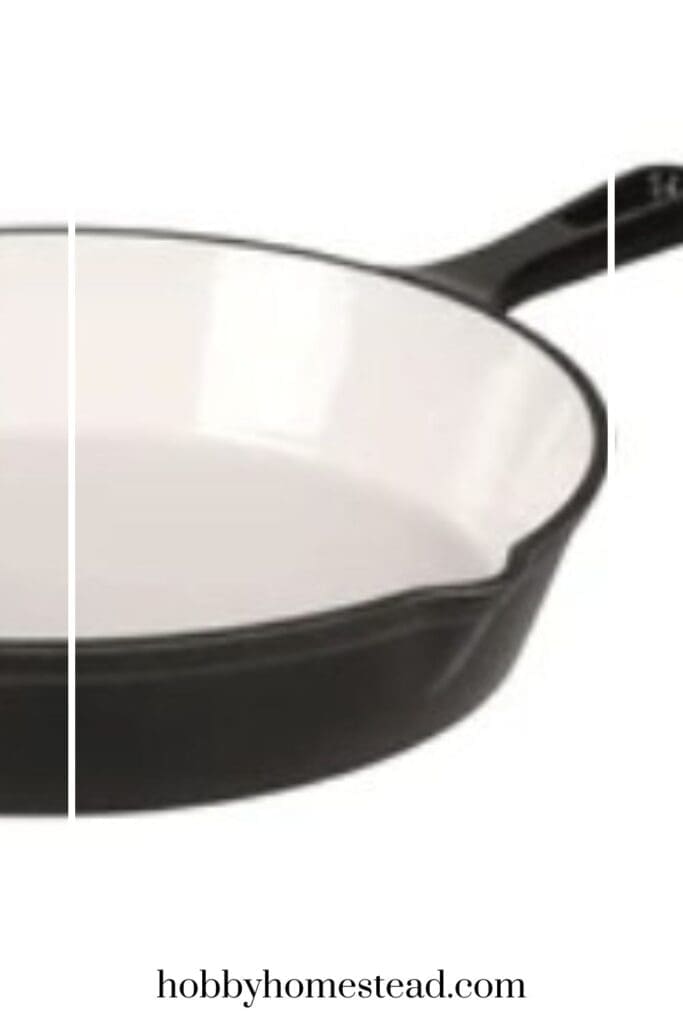Last updated on April 25th, 2025 at 10:21 am
Learning how to clean a cast-iron skillet or cookware for that matter is crucial for maintaining its non-stick coating and preventing rust. If you have any cast-iron cookware, you know that proper care is essential for keeping it in good shape.
These durable cast-iron pans require seasoning to maintain their nonstick surface and prevent rust. The best part? With the right maintenance, your cast-iron cookware can last a lifetime—improving with years of use. Here’s how to clean, season, and care for your skillet the right way.
A cast iron skillet is a kitchen staple that, with proper care, can last for years of use—even generations. Popular belief holds that you should never use soap or water, but in reality, the best way to clean cast-iron pans is simpler than you might think. We have some cookware that is over 60 years old. Once you realize how easy it is to maintain, you’ll be hooked on using this too. No non-stick coating to peel off and get in your food.

Caring for Our Cast-Iron Cookware
When I was growing up, we only used cast-iron pans. We also had a few enameled cast-iron pans. We used them every day. But we did care for them differently.
If you are interested in using this type of cookware, you can purchase it new. Often, they are pre-seasoned. Sometimes, if you’re lucky, you can find an old cast iron at yard sales, don’t worry. Many can be restored with a little elbow grease.
What to Avoid When Cleaning Your Cast Iron skillet?
There are a few things to keep in mind to keep your skillet in good shape and prevent rust from forming.
- When cleaning a non-enameled cast-iron, don’t put it in the dishwasher.
- For all cast-iron, don’t soak it in water overnight.
Doing either of these things can ruin the pan’s seasoning and also contribute to rusting.
Avoid using steel wool or other harsh materials to clean your cast-iron skillet. This can also damage the seasoning.
What materials do I need to clean a cast iron?
The way you clean your cast-iron skillet can impact the staying power of its seasoning and its overall longevity. To properly clean a cast-iron skillet, gather the following materials.
Basic Cleaning Supplies
- Hot water. Helps loosen food residue without damaging the seasoning.
- Coarse salt or kosher salt. Acts as a natural abrasive to scrub away stuck-on food.
- Pan scraper or plastic scraper. Helps remove food bits without scratching the cooking surface.
- Mild dish soap (optional). A small amount of soap can be used for tougher messes.
- Non-abrasive sponge or scrub brush. Gentle enough for regular use.
For Rust Removal
- Steel wool. Removes light rust from the entire surface of a rusty cast iron pan.
- Baking soda or vinegar (optional. Helps lift stubborn rust spots.
Drying and Seasoning
- Clean towel or lint-free cloth. Dries the pan completely to prevent rust.
- Clean paper towel. Used for applying oil to the pan.
- Neutral oil (e.g., flaxseed oil, vegetable oil, canola oil, olive oil, or grapeseed oil). Creates a protective non-stick coating.
- Aluminum foil or seasoning spray (optional). Helps with best results when re-seasoning.

How to Clean a Cast-Iron Skillet
Step 1: Let the Pan Cool
Before cleaning, always let your hot pan cool slightly. Pouring cold water on a hot skillet can cause warping and damage the cooking surface.
Step 2: Remove Food Residue
If there are food bits or stuck-on food, use a pan scraper or plastic scraper to remove them. For stubborn bits, add a little water and let the pan sit for a few minutes before scrubbing.
Step 3: Scrub Without Damaging the Seasoning
For light cleaning, a non-abrasive sponge or scrub brush with warm water will do the trick. If there’s stuck-on food, sprinkle coarse salt or kosher salt into the pan. Salt acts as a gentle abrasive to lift food particles. You can also use a little bit of dish soap if needed; despite popular belief, a small amount of soap won’t ruin the pan’s non-stick surface.
Step 4: Dry the Pan Immediately
Never let a dirty cast iron pan air dry. Instead, use a clean towel, lint-free cloth, or clean paper towel to dry it thoroughly. For best results, place it over low heat for a few minutes to evaporate any remaining moisture.
Step 5: Apply a Thin Layer of Oil
Once dry, apply a thin layer of oil, such as olive oil, vegetable oil, flaxseed oil, canola oil, or grapeseed oil, to the entire surface of the pan. Wipe off excess with a clean rag to leave a very light layer of cooking oil. This step prevents rust and maintains the seasoning of the pan.
Keeping Your Cast Iron in Good Shape
- Never soak your cast-iron skillet in water. It can cause rust.
- Avoid abrasive cleaning methods that strip away seasoning.
- Use bacon grease or seasoning spray occasionally to maintain a slick cooking surface.
- A new cast iron pan will require seasoning before regular use.
How to clean a cast iron that has rust?
If your cast iron skillet has developed rust, don’t worry. It can often be restored with a little effort. Follow these steps to clean and re-season a rusty cast iron pan so it can last for years of use.
If your skillet has light rust, scrub it with steel wool and re-season it.
For a rusty cast iron pan, scrub with warm soapy water, dry it completely, and apply a light coat of oil before placing it in an oven at high heat to re-season.
To remove stubborn bits, you can boil water in the pan for a few minutes to loosen them.
Step 1: Scrub Away the Rust
Use steel wool or a scrub brush to remove the rust from the entire surface of the pan.
For light rust, a mixture of coarse salt and a little bit of dish soap can act as an abrasive to help scrub it away.
If the rust is stubborn, try a paste of baking soda and warm water, let it sit for a few minutes, and then scrub.
Step 2: Rinse and Dry Immediately
Once the rust is gone, rinse the pan with hot water and dry it completely using a clean towel, lint-free cloth, or clean paper towel.
To ensure no moisture remains, place the skillet on the stove over low heat for a few minutes.
Step 3: Re-Season the Pan
Apply a thin layer of oil (such as flaxseed oil, vegetable oil, canola oil, or olive oil) to the entire pan, including the handle and bottom.
Use a clean rag or paper towel to wipe off any excess oil—you want a very light layer of cooking oil to avoid a sticky surface.
Place the pan upside down in a high heat oven (around 450°F) for about an hour. If you have a Dutch oven, you can season it the same way.
Preventing Future Rust
- Always dry your cast iron cookware immediately after washing.
- Avoid soaking it in water or using abrasive cleaning methods too often.
Store your cast-iron skillet in a dry place with a light coat of oil on the surface of the pan. If storing for a long time, place a sheet of aluminum foil or a clean paper towel inside the pan to absorb any moisture.

How to Clean an Enameled Cast-Iron Skillet
Unlike traditional cast-iron cookware, an enameled cast-iron skillet has a smooth, porcelain coating that protects it from rust and eliminates the need for seasoning. However, it still requires proper care to maintain its nonstick surface and prevent stains. Follow these steps to keep your enameled cast-iron skillet in good shape for years of use.
What You’ll Need
- Warm water
- Mild dish soap
- Soft sponge or non-abrasive scrub brush
- Baking soda (for tough stains)
- Plastic scraper (for stuck-on food)
- White vinegar (for discoloration)
- Clean towel or lint-free cloth
Step-by-Step Cleaning Instructions
1. Let the Pan Cool First
Never submerge a hot pan in cold water, as it can cause the enamel to crack. Allow the cooking surface to cool before washing.
2. Wash with Warm, Soapy Water
Unlike traditional cast-iron pans, enameled skillets can be cleaned with regular dish soap. Use warm soapy water and a soft sponge to remove food bits and grease.
3. Remove Stubborn Food Residue
For stuck-on food, use a plastic scraper or a little bit of baking soda with warm water to gently scrub the surface of the pan. Avoid using steel wool or other abrasive cleaning methods, as they can scratch the enamel.
4. Tackle Stains with Baking Soda or Vinegar
If your skillet has discoloration from years of use, make a paste with baking soda and water, apply it to the stains, and let it sit for 15 minutes before scrubbing. Alternatively, fill the pan with a mix of hot water and white vinegar, let it soak for 30 minutes, and rinse.
5. Rinse and Dry Thoroughly
After washing, rinse your enameled cast-iron skillet with warm water and dry it completely using a clean towel or lint-free cloth to prevent water spots.

How to Care for Your Pan Once You’ve Removed the Rust?
Wash the pan as you normally would, then dry it thoroughly. When it’s dry, season your pan by rubbing a thin layer of vegetable or cooking oil and baking it in the oven for an hour at 350° degrees Fahrenheit.
Extra Care Tips for Enameled Cast Iron
- Avoid using high heat for extended periods, as it can damage the enamel.
- Do not use metal utensils, as they can chip the non-stick coating.
- Never use abrasive sponges or steel wool, which can scratch the surface.
- Store the skillet in a dry place to prevent moisture buildup.
With these expert tips, you keep your pans in good shape for generations to come.
References
Food Network. How to Clean a Cast-Iron Skillet.
Lodge. How to Clean Cast Iron Cookware.
Martha Stewart. How to Clean a Cast-Iron Skillet.


